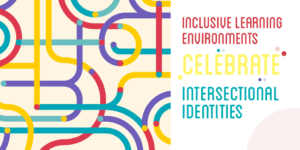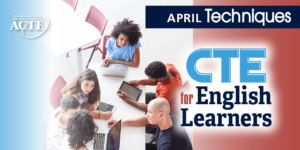Celebrate intersectional identities in CTE
As an immigrant from the Dominican Republic and a person of color, Luis Pérez learned to navigate the United States educational system as a young multilingual learner. Then, when he was diagnosed with a visual impairment at the age of 29, after a series of car accidents, Pérez began to experience life as a person with a disability. His story may be unique, but his situation is not uncommon. Multilingual learners, like Pérez, carry many identities.
There are an estimated 4.9 million children in public schools in the U.S. learning the English language. But like Pérez, being multilingual is not all that defines these students. “We are not check boxes, said Pérez, who is the diversity and inclusion lead at CAST. “We’re more like Venn diagrams.” He also said that an individual’s sense of identity can change. “What’s important to us at one point in our lives may not be as important at another.”
Celebrate intersectional identities.
Race, class, sexual orientation, disability, trauma and other life experiences influence a student’s sense of themselves in the classroom. Our intersectional identities are critical pieces of who we are and how we learn. And they are assets to learning that should be celebrated. “How much richer would education be if we recognized that every learner is unique and has a complex identity that we should celebrate and incorporate into learning?” he asked.
Consider how variable and flexible learning environments are inclusive of all identities. Using Universal Design for Learning (UDL), educators can create solutions that acknowledge and celebrate learners’ differences.
Center the students in their learning.
UDL does not accept curriculum as a given. “There is no one checking that you’ve taught every student each competency in this way,” said Amanda Bastoni, an educational research scientist with CAST. “You might think curriculum is the most important thing in the room, but I would suggest that the learner is the most important thing in the room.”
Rely on three principles to design flexible and intersectional learning environments that empower learners to grow.
- Representation: Creating variability in how concepts are shared with students
- Action and expression: Including multiple options for students to express knowledge
- Engagement: Offering choice to spark interests and autonomy
Create a sense of belonging.
Students can often feel isolated by their unique differences, thinking, “I’m the only one like this.” And this can cause students to withdraw in the classroom. “It’s very challenging to be the only one,” Bastoni said. “I think the most important thing teachers can do is make sure all students feel a sense of belonging.
“Create environments where people can feel like all of them — the whole human being — belongs there and is important.” Further, she said that the National Science Foundation is engaged in studies that examine belonging as a factor influencing whether people choose a certain career, thus indicating its importance in the learning environment.
Design authentic learning experiences.
“If you’re engaged, you’re going to find ways around barriers,” Pérez said. One way to engage students is by designing assignments that allow them to share parts of themselves. Ask photography students to take pictures of trees around their homes. Or ask woodworking students to study their trees.
Model resiliency and representation.
Diverse students must be represented in career development activities. Show them examples of successful and diverse professionals. Pérez recommended inviting guest speakers that represent different identities. Or find a video about intersectional theory on YouTube. Then frame the viewing with discussion prompts.
Ask students to observe elements of the presentation that connect with their own lived experiences, and discuss. Bastoni encouraged educators not to overthink this practice. Even something as simple as putting up representative visuals can be a good start.
Make good use of accessible resources.
Students possess powerful resources at their fingertips and in their pockets. Pérez recommended that educators help students learn how to access assistive technology applications and devices. Text-to-speech apps, customizable visual displays, timers to help with focus and many other accessibility tools can help meet students’ individual learning needs. Pérez also recommended thinking creatively and flexibly about how students create and submit information, which can attend to both accessibility and engagement.
Reach out to students and their families.
Many families face barriers to engagement. Some work two jobs. Others may not speak the language. But family members are critical partners in learning. Seek to remove barriers. (Can you host an event online or post information online? Can you host events at different times?)
Addressing some barriers for students and their families will require support and involvement from others. So don’t be afraid to reach out to others. Counselors can help arrange career exploration opportunities. A student suffering from a trauma or experiencing homelessness may need assistance from a social worker.
While the initial goal of these strategies may be to address the intersectional needs of multilingual learners, they can help educators address the needs of all of their students and make them better educators. “When you have to consider there are different ways that people take in information, and different ways people show understanding, I think you’re going to be a more creative teacher, and that’s going to benefit everybody.”
Laura Bengs is a former educator and freelance writer in the Midwest. She covers education, the arts, parenting, food and beverage, and culture.





